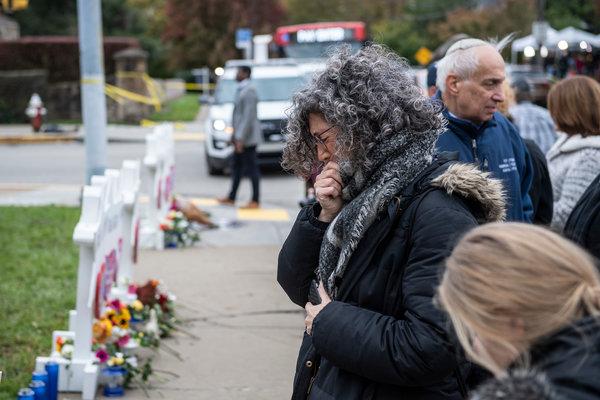STORY BY DANIEL SAENZ
Shortly before Halloween, Pittsburgh experienced one of the worst antisemitic hate crimes in United States history. Bill Browers stormed into the Tree of Life Synagogue and proceeded to open fire, killing eleven people in the process. When captured by police, Browers simply stated that he just wanted to kill Jews. Upon further examination of his social media postings on GAB, authorities found that Browers was an unhinged, antisemite who believed that the members of the Tree of Life Synagogue were importing refugees that would rape women, kill, etc. This was rooted in the existence of the Hebrew Immigrant Aid Society that helps to provide resettlement services to migrants and refugees. He then tied this into the classical antisemitic trope that Jews are part of a worldwide conspiracy to ruin the well-being of ordinary citizens. In order to understand such a tragedy, it is important to note that sadly, this event does not exist in a bubble.
Antisemitism has existed since biblical times and hit its peak in Europe, which would eventually be exported to the United States. During the Middle Ages, the Jews were blamed for the Plague that hit Europe. There also arose the blood libel trope in which Christians accused the Jews of kidnapping their children and using their blood for sacrifices and rituals. This resulted in the massacres of Jews all across Europe, often sanctioned by the Catholic Church.
In fact, up until 1965, the Catholic doctrine was that the Jews were collectively responsible for deicide (or killing Christ or God himself). Protestants took part in this as well. Martin Luther added fuel to the fire by publishing The Jews and Their Lies in 1543. Shortly after the 19th century, people began to add racial characteristics to Jewish people.
Being Jewish was no longer a simple religious label but now a racial label. Jewish people in Europe were portrayed as inferior while also being crafty, wealthy and promoting international communism, and were cosmopolitan (preferring foreign cultures instead of being patriotic to their native countries.). Such tropes culminated in the rise of the Nazis in Germany and the subsequent Holocaust.
Because the founding people of the modern state of the United States were from Europe, antisemitic attitudes have been prevalent throughout United States history as well. Brian Gribben, Coordinator of Government Documents, Archives, and Special Collections at Forsyth Library summed it up.
“By extension, as a country predominantly populated by peoples of European-origin, the United States has not been immune to antisemitism and has its own past to reckon with,” Gribben said. “Traditionally, Jewish-Americans have not experienced the widespread violence endured by, say, Jewish communities in Imperial Russia, where tsarist pogroms were often endemic. Rather, in the United State, anti-Jewish bigotry often assumed the form of a “soft” antisemitism in which slurs and restrictions (sometimes tacit, sometimes overt) in employment and housing were common.”
Gribben also went on to give an example of this antisemitism at play and some of the factors underlying antisemitism in the United States.
“Grotesque acts of violence have also punctuated antisemitism in the U.S., the 1915 lynching of Leo Frank being just one of many examples. It’s my position that violent antisemitism seems to manifest more often during times of uncertainty when the country is undergoing transitional periods,” Gribben said. “Demographic shifts, such as the influx of Jewish immigrants from Eastern Europe around the turn of the twentieth century, can amplify fear of the other. That’s not always the case, as the antisemite doesn’t require a motive beyond their bigotry. However, external factors do matter. Additionally, much like its European counterpart, American antisemitism can sometimes be encouraged by the powerful and employed when politically expedient. One needs to consider this as well.”
Even during the Great Depression, Jewish financiers were blamed for the recession. When FDR was proposing for left-wing policies to combat the recession, opponents of this portrayed such policies as Jewish conspiracies. The United States refused to take in Jewish refugees fleeing persecution during this time as over sixty percent of Americans believed that Jewish refugees from Austria and Germany should be kept out. Throughout the 50s and 60s, white supremacist movements would routinely attack synagogues.
There have been efforts to combat this. The FBI, for example, has worked with the Justice Department’s Civil Rights Division since 1957 to fight against extremist groups that promote antisemitism. There are also organizations such as the Anti-Defamation League and the Southern Poverty Law Center which serve as watchdogs for extremist groups as well as public figures associated with these groups.
In the age of new communication technology, antisemites are able to come out of the shadows louder and more effective than ever. Now, conspiracy theories about George Soros funding the caravan or paying protestors can reach millions of people in less than five minutes and convince them that there is some worldwide “globalist” conspiracy.
So where do we go from here? Gribben provided his final thoughts.
“When we educate ourselves, we can recognize the forms antisemitism assumes even when it’s understated, dog whistles like “globalist,” the winks and nods and so on,” he said. “Moreover, we can help others recognize them. That puts us in a better position to assess the words and actions of others and respond accordingly. Above all, we should support each other. Embrace the humanity in each of us and support others who do the same.”

